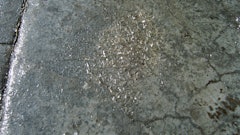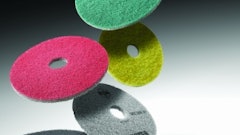
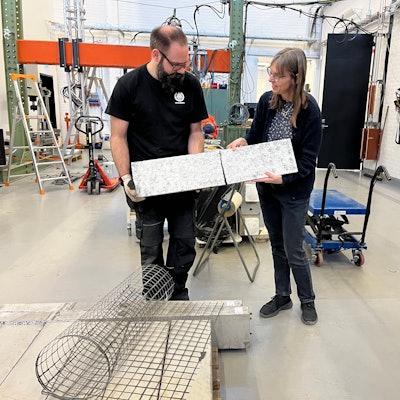 Sebastian Almfeldt and Karin Lundgren at Chalmers University of Technology, Sweden, are two of the authors of a scientific article describing a new method that facilitates calculations of complex structures of textile-reinforced concrete. Here they show a carbon fibre reinforced concrete slab, the load-bearing capacity of which has been tested in the construction lab at Chalmers. In the foreground is a textile reinforcement mesh made of carbon fiber.Chalmers University of Technology | Photo by Mia Halleröd Palmgren
Sebastian Almfeldt and Karin Lundgren at Chalmers University of Technology, Sweden, are two of the authors of a scientific article describing a new method that facilitates calculations of complex structures of textile-reinforced concrete. Here they show a carbon fibre reinforced concrete slab, the load-bearing capacity of which has been tested in the construction lab at Chalmers. In the foreground is a textile reinforcement mesh made of carbon fiber.Chalmers University of Technology | Photo by Mia Halleröd Palmgren
"A great deal of the concrete we use today has the function to act as a protective layer to prevent the steel reinforcement from corroding. If we can use textile reinforcement instead, we can reduce cement consumption and also use less concrete − and thus reduce the climate impact," says Karin Lundgren, who is Professor in Concrete Structures at the Department of Architecture and Civil Engineering at Chalmers.
According to the Portland Cement Association's (PCA) Roadmap to carbon neutrality, the U.S. Environmetnal Protection Agency states that the manufacture of cement accounts for 1.25% of U.S. carbon dioxide (CO2) emissions alone. Globally, about 4.5 billion tons of cement are produced, which accounts for 8% of the worlds CO2 emissions. Clever people the world over are ever-constant in developing innovative solutions and methods to construct more sustainable concrete structures.
"Given that the United Nations Environment Programme expects the total floor area in the world to double over the next 40 years due to increased prosperity and population growth, we must do everything we can to build as resource-efficiently as possible to meet the climate challenge," says Karin Lundgren.
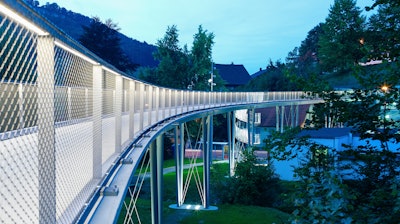 The pedestrian and bicycle bridge in Albstadt, Germany, is an early example of a textile-reinforced concrete structure. The bridge is about 100 meters long.Chalmers University of Technology
The pedestrian and bicycle bridge in Albstadt, Germany, is an early example of a textile-reinforced concrete structure. The bridge is about 100 meters long.Chalmers University of Technology
Thinner Constructions & Alternative Binders
The construction industry may be able to further reduce its CO2 footprint. Efforts began by moving away from ordinary cement to one with a higher limestone content - a PLC. Likewise, other companies are promoting the increased use of fly-ash, as well as reclaiming discarded fly-ash from sites once thought as waste. By using alternative binders instead of cement, such as clay or volcanic ash, it is possible to further reduce carbon dioxide emissions. It is unclear how well such new binders can protect steel reinforcement in the long term.
"You could get away from the issue of corrosion protection, by using carbon-fibres as reinforcement material instead of steel, because it doesn't need to be protected in the same way. You can also gain even more by optimising thin shell structures with a lower climate impact," says Lundgren.
In the study "Textile reinforced concrete members subjected to tension, bending, and in-plane loads," published in the Construction and Building Materials journal (December 2023), Lundgren and colleagues describes "a new modelling technique that was proved to be reliable in analyses describing how textile reinforcement interacts with concrete." She explains: "What we have done is to develop a method that facilitates the calculation work of complex structures and reduces the need for testing of the load-bearing capacity." The study was written by Adam Sciegaj, Sebastian Almfeldt, Fredrik Larsson and Lundgren. At the time of the study, the authors were active at Chalmers University of Technology and Gdansk University of Technology in Poland. Gabriel Edefors is also working in the doctoral project that continues the study at Chalmers. The research projects that form the basis of the article are funded by the Swedish Research Council.
One area where researchers see that textile reinforcement technology could significantly reduce the environmental impact is in the construction of arched floors. An April 2022 research study from the University of Cambridge was able to show that textile reinforcement can reduce carbon dioxide emissions by up to 65% compared to a traditional solid concrete floor.
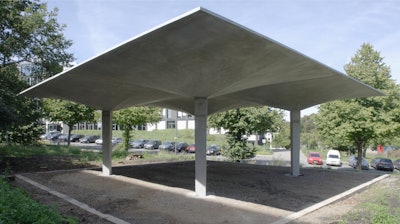 Picture from the construction of a pavilion at the RWTH Aachen University of Technology in Germany. The shell-shaped roof structure has been reinforced with carbon fibre textile and is only six centimetres thick.Chalmers University of Technology | Photo by Robert Mehl
Picture from the construction of a pavilion at the RWTH Aachen University of Technology in Germany. The shell-shaped roof structure has been reinforced with carbon fibre textile and is only six centimetres thick.Chalmers University of Technology | Photo by Robert Mehl
A Textile Reinforcement Mesh
A textile reinforcement mesh consists of yarns, where each yarn consists of thousands of thin filaments (long continuous fibres). The reinforcement mesh is cast into concrete, and when the textile-reinforced concrete is loaded, the filaments slip both against the concrete and against each other inside the yarn. A textile yarn in concrete does not behave as a unit, which is important when you want to understand the composite material's ability to carry loads. The modelling technique developed by the Chalmers researchers describes these effects.
Lundgren explains it as the yarn consisting of an inner and outer core, "which is affected to varying degrees when the concrete is loaded." She and her team developed a test and calculation method to describe this interaction.
"In experiments, we were able to show that our way of calculating is reliable enough even for complex structures," says Lundgren.
The work together with colleagues is now continuing to develop optimisation methods for larger structures.



